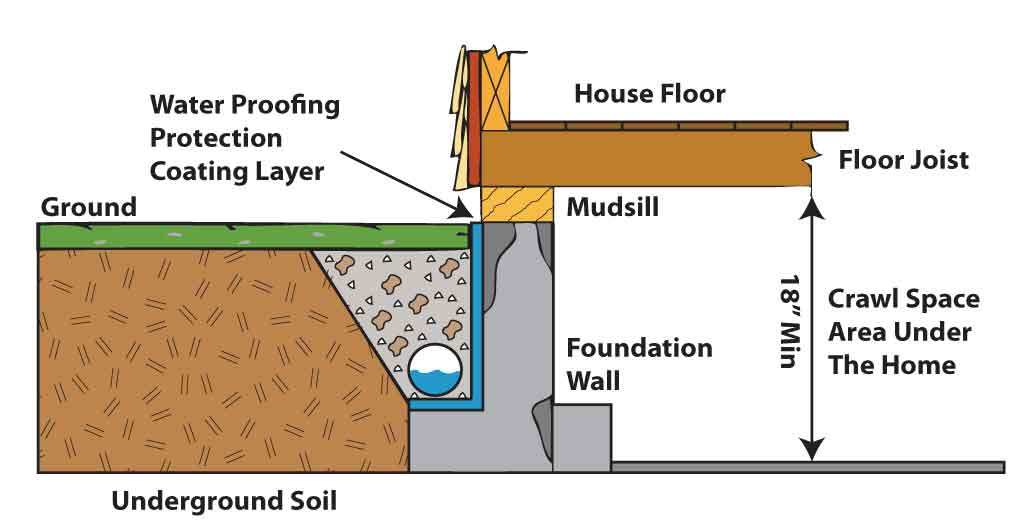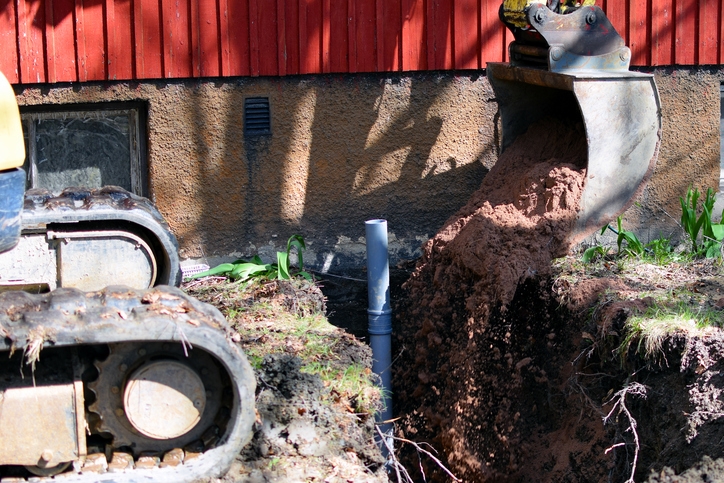Drain tile offers optimum protection as it directs water away from your home via an underground piping system. Water removal is one of the most important precautions you can take as a homeowner. There isn’t a structure that’s impervious to water. Wood, concrete, metal, you name it, water will always win.

When you imagine building a home you might not envision yourself putting up a frame and picking out flooring. And you may not imagine choosing a draining system. However, we going to change that and more.
Before we go further, you should that when we say drain “tile,” what we’re talking about has nothing to do with traditional tile. The term is derived from its origins back when the systems were made of clay.
Today, drain pipes are made from PVC or other plastic materials. There are a few types of drain tiles systems, and all of them connect to your drainage system.
What Is A Drain Tile System?

A drain system is a way to help groundwater irrigate to a specific area and keep it away from basements and crawlspaces. Not all houses have drain systems but many need them so homeowners choose a drain tile system. Drain tile is a perforated PVC pipe that is buried beneath the foundation of a house.
Water leakage in a basement is the most common problem. It could come from water running down your walls, or puddles forming around your property. However, when you have drain tile, you’ll be protected from these issues and more.
The system prevents water from entering your basement or crawlspace by directing it to a drain field or designated wastewater area. It isn’t always buried though and can be found outside of the home.
Modern Drain Tile
If you live on a hill or near one and you happen to be on the upper side of that hill, then the drain tile will direct water down this hill. If you don’t, then it will be directed to a sump pit or sump tank instead.
From there, the water is pumped out into a drain field where it can safely sink into the ground. The pipes that direct the water are usually made from plastic and are PVC. These PVC pipes are usually crush-resistant and perforated.
An alternate type of pipe would be a flexible pipe that allows more control over where the pipe is placed and works better with lots of turns. Because the snake pattern drains better than multiple right angles.
Most drain pipe is installed whenever the foundation is installed. But if it is an afterthought, then it can be installed next to the foundation with pipes being fed through the basement ceiling and walls.
It’s important that the majority of the drain pipe is a few feet underground. If this isn’t possible then other options are probably better. Check out septic systems for private homes and how they work for more info.
Why Is A Drain Tile System Important?
If you have a concrete, CMU, or brick foundation, then there’s a good chance you won’t have a choice as to whether to get a drain tile system or not. Because many regions require you to have one with these foundations.
However, if the foundation is installed on well-drained soil acting as a natural drainage system, it may pass the test. If this is the case, it won’t be necessary, but you may still want to add one just in case.
If you have a drain tile system, the chances of flooding and leaks in the home are far less. And it is much easier to install the system when you build your house as opposed to whenever you run into a problem with water.
Drain Tile Installation
You’ll need to sit down and do some number crunching to determine if the juice would be worth the squeeze. With drain tile installation, you have a few options. You can install the drainage system in your basement, outside of your foundation, or in your yard.
The most important thing about installation is to make sure your drainage pipe is covered with a mesh sock. This precaution is necessary because it prevents sand and soil from getting inside and clogging the drain.
Dig A Trench
Dig a trench in the area that you have marked for your pipe. You will need a large area for the dry well and the overflow tube. The rest will be a trench that is about a foot wide and a couple of feet deep.
If you can’t get through the soil, dig around to find soil that will work. The trench might be a little longer than anticipated, but if that happens, you’ll need to slope the trench.
Start at ground level and keep going down about an inch every ten feet. Make sure you slope at least one percent or one inch every ten feet. If you don’t, the drain won’t work.
Drywall Installation
Knock out the perforated circles in the drywall. This is where the pipe will enter, along the sides of the drywall. You may need to score it before you knock it out with a hammer. Then you can begin assembling it.
You will assemble it as you would a piece of furniture. Each piece goes together, then the lid on top of the round barrel. Followed by the drain pipe cover which allows access.
Finally, add a weed barrier to the hole and cover the drywall with it. Then, lower the drywall into the hole. After that, you need to connect the pipes and start laying the drain tiles or French drain into the trench.
Add Base Layer
You want to make sure you add a few inches of gravel over the base of the trench. You can get by with a couple of inches but three to four inches is recommended. It is also recommended to add a weed barrier on the bottom.
You can use almost any type of gravel but a simple medium to small-sized gravel will do. Pea gravel is a good choice but as long as the gravel isn’t porous or easily broken then it should be good. Also, gravel that isn’t sharp is ideal.
As for weed barriers, this is fairly easy. You can use any weed barrier made to go underground. Not one that will decompose but one that will be there for you without harming the environment. Most weed barriers will work.
Related: How To Implement A Swale Drain
Set The Pipes
Now you want to cover the tubes in a weed barrier before you place them. After you do this, you can place the pipes in the ground and attach the downspout to the main drain line. Then cover it with gravel.
Then attach the pipe to the tank where directed. After this, all you need to do is add gravel where you don’t want the pipe to move and fill the rest in with dirt. For French drains, the top layer is filled with gravel.
Gravel is easier to remove in order to reach the pipe but either works as long as the weed barrier is in place to keep soil out of the perforated holes of the pipe. Just don’t forget to add a cover to the end of the pipe!
Good Appearance
There are many ways to finish off a French drain or drain tile system. After you fill it up, you can add gravel to create a pretty dry creek bed, which can look amazing and magical like a woodland forest.
You can add sod, which will work well if you don’t want to have to plant grass that will cover the drain. With some types of sod, you can remove it anytime to check on the drain or make pipe repairs.
Hiring A Professional
Even if you do have a simple system in mind, hiring a professional is your best option. They can get the job done in no time and the host is almost always worth it. Make sure you check for reviews before hiring someone.
It’s important that you hire a good company or contractor to do the job. Ask for references and compare quotes before deciding on who to hire. You can ask your realtor or general contractor for contacts as well.
This is just as important as painting your walls or hanging lighting. It can be even more important because it isn’t just visual. It will affect your quality of life and prevent problems in the future. So make it count.
Frequently Asked Questions (FAQ)FAQ
What Is A Swale?
A swale is a small ditch that fits between your property and your neighbor’s property. The ditch is used to push the slope away from your house so water will drain into it so it can be carried away from your foundation.
What Is Vapor Diffusion?
The movement of moisture in its vapor state through a certain material. It relies on the permeability of the material and is the driving force of vapor pressure. In a basement, vapor can diffuse from a watery surface through concrete walls and floors and move toward dry interior areas.
How To Fix Inadequate Grading?
Spread soil around your home until it slopes away from the foundation wall. You’ll need to do this at least one inch per foot for a minimum of six feet. When the ground around a foundation is level or slopes toward your house, water will be directed into the basement.
How To Fix A Sump Pit That Doesn't Work?
Broken sump pits need to be replaced you’ll need to redirect excess water with something else. A sump pit is important as it lifts water to the surface outside the foundation wall.
Is Dehumidification A Good Way To Remove Water From My Basement?
The problem with dehumidification is that it’s a temporary solution for water removal. It lowers humidity symptoms and odors, but that’s it. And dehumidifiers could make things worse. When drying basement air, moisture is drawn into the space which can cause efflorescence and concrete spalling.
Drain Tile Conclusion
Drain tile relieves hydrostatic pressure by giving water seepage from soil or cracks an exit path away from your home. Another benefit of a drain tile system is that it keeps water away from your lawn and garden so your greenery can receive the oxygen it needs for healthy growth.
When plant nutrients are cycling, there are three aspects that require your attention. There’s the chemical aspect, which includes your pH level as it interacts with different nutrients. There’s also the biological aspect and soil structure.
Drain tile relieves hydrostatic pressure by giving water seepage from soil or cracks an exit path away from your home. Another benefit of a drain tile system is that it keeps water away from your lawn and garden so your greenery can receive the oxygen it needs for healthy growth.
The post Drain Tile Systems Offer Ultimate Protection For Your Home appeared first on Homedit.





0 Commentaires